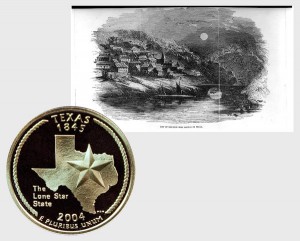Today, the Texas State Quarter Coin remembers the date the people and area joined the American Union of States.
In A Complete History of Texas, published in 1899, Dudley G. Wooten provided insight into the struggles of the Texans 171 years ago.
An excerpt:
=====
In September, 1836, six months after Texas had achieved her independence, Mr. Henry M. Morfit was sent by the President of the United States to investigate the condition of the new Republic, and he reported as follows: Total estimated population, 52,670, — consisting of 30,000 Anglo-Americans, 14,200 Indians, 5000 negroes, and 3470 Mexicans.
At the date of the inauguration of the first president of the Republic, the whole country and its people were in a deplorable state of prostration and poverty; there were no stable industries of any kind; transportation was difficult and trade practically suspended; the country was rapidly filling up with a class of immigrants not so desirable as the original colonists; while ambitious and reckless men, released from the dangers of war and the incentive of patriotic devotion to the cause of freedom, instigated many wild and adventurous schemes.
All that the infant government possessed was a vast landed domain, valued very slightly, but sufficiently tempting to arouse the spirit of cupidity and speculation among the unscrupulous and the improvident.
There were practically no schools, but one newspaper had survived the Revolution, and the government itself was without a fixed habitation.
The next ten years were filled with doubts, debts, and difficulties innumerable, and at times apparently insurmountable; but the result, wrought amid many perils and privations, culminated in the ultimate redemption of the government from all its embarrassments, the assured prosperity of a thrifty and increasing population, and its incorporation as a stable commonwealth among the States of the American Union.
The Joint Resolution of the Congress of the United States for the annexation of Texas was approved March 1, 1845.
In accordance with its terms a State Constitution was framed and adopted by the Texas Convention, August 27, 1845, was submitted to a vote of the people, together with the question of annexation, in the following October, and, by a vote of 4174 for to 312 against, it was ratified by the people of Texas.
On December 29, 1845, the Constitution thus framed and adopted was accepted by the Congress of the United States, and from this last-named date Texas legally became one of the United States of America.
The new State government, however, which was elected in December, 1845, did not assume its functions until the following February, 1846.
For purposes of practical computation we may adopt January 1, 1846, as the beginning-point in the history of Texas as an American State, so that on January 1, 1896, she closed her first half-century of Statehood.
No official census of the Republic was ever taken, and the number of its inhabitants can only be estimated by the popular vote at the successive elections, aided by some attempts that were made at enumerating the population of various countries.
The vote at the several elections from 1836 to 1849 was as follows:
For first President, September, 1836 —5,704
For second President, September, 1838 —7,247
For third President, 1841 —11,534
For fourth and last President, 1844 —12,689
For first Governor, 1845 —9,578
For second Governor, 1847 —14,767
For third Governor, 1849 —21,715
Upon the basis of ten inhabitants for every voter, the election of 1845 would show a population of 95,780; or, taking the preceding election of 1844 as more nearly representative, the population at the date of annexation would be 126,890, which is no doubt a very liberal estimate.
It is more probable that the entire population, including the Indians, did not exceed 100,000.
In 1847 a partial enumeration by counties was made, showing 135,777 inhabitants, including 38,729 slaves.
These inhabitants were for the most part located in Eastern Texas and along the Trinity, Colorado, and Brazos Rivers from the coast as far inland as the Old San Antonio Road, with a considerable settlement at San Antonio, and a fringe of floating population along Red River and the Rio Grande.
There was no city of any size, no trade centre, few roads of the roughest character, no internal trade of much value, and a primitive scarcity of all those things that constitute modern civilization in its most vigorous attitude.
The Mexican War, which at once broke out in 1846 as the result of annexation, retarded further immigration for a time, and it was not until after 1848 that the country began to really develop in its population and resources.
In 1850 the first census was taken, showing a population of 212,592, of whom 154,034 were white and 58,161 were colored.
The composition of this inhabitancy was cosmopolitan in a very marked degree, and in that regard it was the prototype of the character of the Texan citizenship of all the subsequent years to the present time.
Perhaps no other American State has had so unique a blending of nationalities and social types.
Although what may be called the staple of the population— that element which gives complexion and a permanent character to social life and customs — has from the first been derived from the Southern States of the American Union, there has always been such a large and influential admixture of immigrants from the North and East, together with a vigorous and healthy foreign colonization from Germany, Sweden, Norway, Denmark, Bohemia, France, and Great Britain, to say nothing of the Spanish and Mexican influences that originally underlay all the others, that the resultant Texan is a composite citizen of a common wealth that possesses peculiar excellencies for rapid and liberal growth.
…
=====
The Texas State Quarter Coin shows with an image of Houston, the capital of Texas in 1845.
